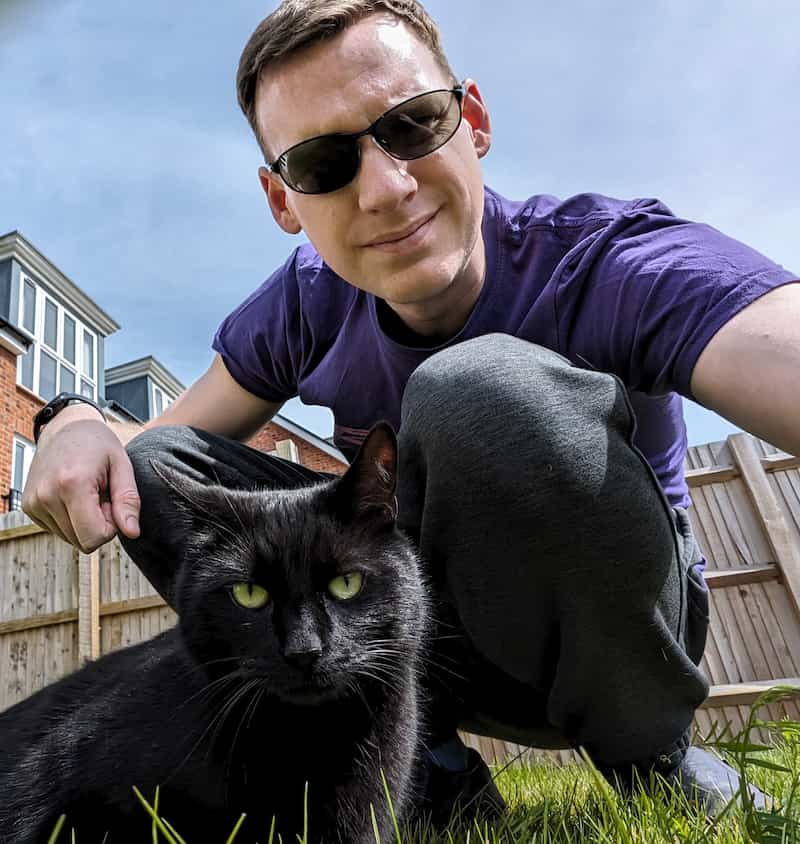Animating zooming using CSS: transform order is important… sometimes
I was using Discord the other day. I tapped to zoom into an image, and it animated in an odd way that I'd seen before. Like this:


Notice how it kinda 'swoops' into the wildcat's face, rather than zooming straight in? See how the right-hand side of the cat's head goes out-of-frame, and then back in again?
I recognised it immediately because I'd made the same mistake myself on another project.
The CSS is pretty simple:
.demo {
transition: transform 1s ease;
}
.demo.zoom {
transform: scale(3) translate(-33.1%, 20.2%);
}But watch this… If I change the starting transform from the default (none), to rotate(0):
.demo {
transition: transform 1s ease;
transform: rotate(0);
}
.demo.zoom {
transform: scale(3) translate(-33.1%, 20.2%);
}The animation changes:


Weird, huh? You wouldn't expect something like rotate(0), which is equivalent to none, to completely change how the animation works, but this is happening entirely as designed in the CSS spec.
Let's dig into why.
What caused the quirky animation?
Let's remove the rotate(0) for now and go back to the original code:
.demo {
transition: transform 1s ease;
}
.demo.zoom {
transform: scale(3) translate(-33.1%, 20.2%);
}When zooming into part of an element, scale(n) translate(x, y) feels like the easiest way to do it. You use the translate to get the subject into the centre, then adjust the scale to zoom in. Tweaking the values in DevTools is easy, as is calculating the values in code.
However, while this order of values is easy to write, it doesn't produce the most natural animation.
How transforms are animated
The CSS spec has a somewhat complex algorithm to decide how to animate transforms. For our values, it takes the from and to values:
@keyframes computed-keyframes {
from {
transform: none;
}
to {
transform: scale(3) translate(-33.1%, 20.2%);
}
}…and begins by padding them out, so they have the same number of components:
@keyframes computed-keyframes {
from {
transform: none none;
}
to {
transform: scale(3) translate(-33.1%, 20.2%);
}
}Then, for each from and to pair of components, it converts them to use a common function that can express both types of value. In this case:
@keyframes computed-keyframes {
from {
transform: scale(1) translate(0, 0);
}
to {
transform: scale(3) translate(-33.1%, 20.2%);
}
}Now that the transforms are in a similar format, it produces an animation that linearly interpolates each component separately. This means that the scale is animated linearly from 1 to 3, and the translate is animated linearly from 0, 0 to -33.1%, 20.2%.
The animation itself isn't linear, as easing is applied, but linear interpolation is used as a starting point.
The problem is, with scale followed by translate, the scale acts as a multiplier for the translate values. Therefore, as the scale increases, even though the translate values are interpolated linearly, the effect is non-linear:


At the start of the animation, a 1px shift in the translate value results in a ~1px shift on screen, as the scale is ~1. But, towards the end of the animation, a 1px shift in the translate value results in a ~3px shift on screen, as the scale is ~3. The position appears to change faster towards the end of the animation, which creates the 'swooping' effect.
How to fix it
To fix this, we need to avoid the scale acting as a multiplier for the translate, and the way to do this is to put the translate first.
We can't just swap the order, since we're relying on the multiplying effect of the scale to make the translate do the right thing. To achieve the same effect, we need to manually multiply the translate values by the scale value:
.demo.zoom {
transform: translate(-99.3%, 60.6%) scale(3);
}And that's it!


Although the translate values are still multiplied, they're multiplied by a constant 3, the end scale, rather than a changing scale value. The result is a steady move towards the target. Each 1px shift in the translate value results in a 1px shift on screen.
Unfortunately, this format is harder to tweak in DevTools, but you can fix that with a bit of calc!
.demo.zoom {
--scale: 3;
--x: -33.1%;
--y: 20.2%;
transform: translate(
calc(var(--x) * var(--scale)),
calc(var(--y) * var(--scale))
)
scale(var(--scale));
}Or even, split the transform into two separate properties:
.demo.zoom {
--scale: 3;
--x: -33.1%;
--y: 20.2%;
scale: var(--scale);
translate: calc(var(--x) * var(--scale)) calc(var(--y) * var(--scale));
}When you use the scale and translate properties separately, the translate is always applied first—which just happens to be the order we want.
Job done!
But wait, why did rotate(0) fix it?
Back at the start of the article (remember that?), I mentioned that the animation could be 'fixed' by making the starting transform rotate(0):
.demo {
transition: transform 1s ease;
transform: rotate(0);
}
.demo.zoom {
transform: scale(3) translate(-33.1%, 20.2%);
}Even though the scale and translate are in the wrong order, we get the animation we want. What gives? Well, I don't actually recommend using this 'fix', because it only 'works' by hitting an edge case in the CSS spec.
Let's go through the algorithm again, but this time with the rotate(0) transform:
@keyframes computed-keyframes {
from {
transform: rotate(0);
}
to {
transform: scale(3) translate(-33.1%, 20.2%);
}
}As before, it pads out the values with none so they have the same number of components:
@keyframes computed-keyframes {
from {
transform: rotate(0) none;
}
to {
transform: scale(3) translate(-33.1%, 20.2%);
}
}Then, as before, it tries to convert each component pair to use a common function that can express both types of value. However, it can't. rotate and scale are considered too different to be converted into a common type.
When this happens, it 'recovers' by converting those values, and all following values, to a single matrix:
@keyframes computed-keyframes {
from {
transform: matrix(1, 0, 0, 1, 0, 0);
}
to {
transform: matrix(3, 0, 0, 3, -673.75, 231.904);
}
}And then it animates them as it would two matrices. The 'incorrect' order of the scale and translate is lost, and the translate is already pre-multiplied by the scale. By coincidence, it animates exactly the way we want it to.
Bonus round: scale vs 3D translate
In this article, we've been animating scale to achieve the effect of 'zooming in'. But, depending on the effect you want, you could use a 3D translate instead.
When you animate scale, the result is that the width and height of the target changes linearly throughout the animation (although, as before, easing can be applied). This feels similar to a camera zoom effect.
However, you may want an effect that's more like the object moving towards the camera, or the camera moving towards the object. To achieve this, you don't want the visual size of the object to change linearly.
This is because, when a far-away object moves by 1 metre, the amount of space it takes up in your field of view doesn't change much. But, when a close-up object moves by 1 metre, the amount of space it takes up in your field of view changes a lot. This is the effect of perspective.
So, instead of using scale, let's use the perspective property, and a 3D transform:
.container {
perspective: 1000px;
}
.demo.zoom {
translate: -33.1% 20.2% 666.666px;
}The rather demonic translate-z value was calculated by converting the scale to a translate-z value, using the following formula:
const scaleToTranslateZ = (scale, perspective) =>
(perspective * (scale - 1)) / scale;And here's the result:


Ok, it's subtle. Here's the scale version again for comparison:


It's mostly noticeable on the zoom-out part of the animation. The 3D version feels like it starts much faster than the scale version. Personally, I think the scale version feels better, since the intention is more of a 'zoom' than a 'move'. But, it's good to know the differences, so you can choose the right one for your desired effect.
Thanks to Ana Rodrigues for feedback that helped this make a lot more sense.
